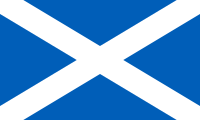
A | B | C | D | E | F | G | H | CH | I | J | K | L | M | N | O | P | Q | R | S | T | U | V | W | X | Y | Z | 0 | 1 | 2 | 3 | 4 | 5 | 6 | 7 | 8 | 9
As of the 2022 census, None was the largest category of belief in Scotland, chosen by 51.1% of the Scottish population identifying when asked: "What religion, religious denomination or body do you belong to?"[1] This represented an increase from the 2011 figure of 36.7%. 38.8% identified as Christian with most of them declaring affiliation with the Church of Scotland (52.5% of Christians; 20.4% of the total population) and the Catholic Church (34.3% of Christians; 13.3% of the total population). The only other religious persuasions with more than 1% affiliation were 'Other Christian' and Muslim at 5.1% and 2.2% of the total population, respectively.
The Church of Scotland, a Presbyterian denomination often known as The Kirk, is recognised in law as the national church of Scotland. It is not an established church and is independent of state control. The Catholic Church is especially important in West Central Scotland and parts of the Highlands. Scotland's third largest church is the Scottish Episcopal Church.[2] There are also multiple smaller Presbyterian churches, all of which either broke away from the Church of Scotland or themselves separated from churches which previously did so. The 2019 Scottish Household survey had a rate of the proportion of adults reporting not belonging to a religion of 56%. The trend of declining religious belief coincided with a sharp decrease since 2009 in the proportion of people who report that they belong to the Church of Scotland, from 34% to 20% of adults.
Other religions have established a presence in Scotland, mainly through immigration and higher birth rates among ethnic minorities. Those with the most adherents in the 2022 census are Islam (2.2%, up from 1.4% in 2011), Hinduism (0.6%), Buddhism (0.3%) and Sikhism (0.2%). Minority faiths include Modern Paganism and the Baháʼí Faith. There are also various organisations which actively promote humanism and secularism. Since 2016, humanists have conducted more weddings in Scotland each year than either the Catholic Church, Church of Scotland, or any other religion and by 2022 the number of humanist marriages outnumbered all religious ceremonies combined.[3][4]
Census statistics
The statistics from the 2022, 2011 and 2001 censuses are set out below.
Religion in Scotland (2022)[5]
| Current religion | 2001[6] | 2011[7][8] | 2022[9] | |||
|---|---|---|---|---|---|---|
| Number | % | Number | % | Number | % | |
| Christianity | 3,294,545 | 65.1 | 2,850,199 | 53.8 | 2,110,405 | 38.8 |
| –Church of Scotland | 2,146,251 | 42.4 | 1,717,871 | 32.4 | 1,107,796 | 20.4 |
| –Catholic | 803,732 | 15.9 | 841,053 | 15.9 | 723,322 | 13.3 |
| –Other Christian | 344,562 | 6.8 | 291,275 | 5.5 | 279,287 | 5.1 |
| Islam | 42,557 | 0.8 | 76,737 | 1.4 | 119,872 | 2.2 |
| Hinduism | 5,564 | 0.1 | 16,379 | 0.3 | 29,929 | 0.6 |
| Buddhism | 6,830 | 0.1 | 12,795 | 0.2 | 15,501 | 0.3 |
| Sikhism | 6,572 | 0.1 | 9,055 | 0.2 | 10,988 | 0.2 |
| Judaism | 6,448 | 0.1 | 5,887 | 0.1 | 5,847 | 0.1 |
| Paganism[a] | — | — | — | — | 19,113 | 0.4 |
| Other religion | 26,974 | 0.5 | 15,196 | 0.3 | 12,425 | 0.2 |
| No religion | 1,394,460 | 27.6 | 1,941,116 | 36.7 | 2,780,900 | 51.1 |
| Religion not stated | 278,061 | 5.5 | 368,039 | 7.0 | 334,862 | 6.2 |
| Total population | 5,062,011 | 100.0 | 5,295,403 | 100.0 | 5,439,842 | 100.0 |
History
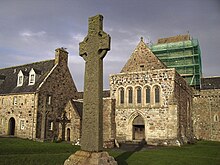
Christianity was probably introduced to what is now southern Scotland during the Roman occupation of Britain.[10][11] It was mainly spread by missionaries from Ireland from the 5th century and is associated with St Ninian, St Kentigern, and St Columba.[12] The Christianity that developed in Ireland and Scotland differed from that led by Rome, particularly over the method of calculating Easter and the form of tonsure, until the Celtic church accepted Roman practices in the mid-7th century.[13] Christianity in Scotland was strongly influenced by monasticism, with abbots being more significant than bishops.[14] In the Norman period, there were a series of reforms resulting in a clearer parochial structure based around local churches; and large numbers of new monastic foundations, which followed continental forms of reformed monasticism, began to predominate.[14] The Scottish church also established its independence from England, developing a clear diocesan structure and becoming a "special daughter of the see of Rome" but continued to lack Scottish leadership in the form of archbishops.[15] In the late Middle Ages the Crown was able to gain greater influence over senior appointments, and two archbishoprics had been established by the end of the 15th century.[16] There was a decline in traditional monastic life but the mendicant orders of friars grew, particularly in the expanding burghs.[16][17] New saints and cults of devotion also proliferated.[15][18] Despite problems over the number and quality of clergy after the Black Death in the 14th century, and evidence of heresy in the 15th century, the Church in Scotland remained stable.[19]
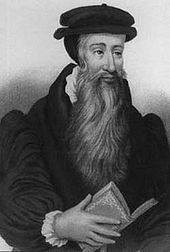
During the 16th century, Scotland underwent a Protestant Reformation that created a predominantly Calvinist national kirk, which was strongly Presbyterian in outlook. A confession of faith, rejecting papal jurisdiction and the mass, was adopted by Parliament in 1560.[20] The kirk found it difficult to penetrate the Highlands and Islands, but began a gradual process of conversion and consolidation that, compared with reformations elsewhere, was conducted with relatively little persecution.[21] James VI of Scotland favoured doctrinal Calvinism but supported the bishops.[22] Charles I of England brought in reforms seen by some as a return to papal practice. The result was the Bishop's Wars in 1639–40, ending in virtual independence for Scotland and the establishment of a fully Presbyterian system by the dominant Covenanters.[23] After the Restoration of the Monarchy in 1660, Scotland regained its kirk, but also the bishops.[24] Particularly in the south-west many of the people began to attend illegal field conventicles. Suppression of these assemblies in the 1680s was known as "the Killing Time". After the "Glorious Revolution" in 1688, Presbyterianism was restored.[25]
The Church of Scotland had been created in the Reformation. Then the late 18th century saw the beginnings of its fragmentation around issues of government and patronage, but also reflecting a wider division between the Evangelicals and the Moderate Party.[26] In 1733 the First Secession led to the creation of a series of secessionist churches, and the second in 1761 to the foundation of the independent Relief Church.[26] These churches gained strength in the Evangelical Revival of the later 18th century.[27] Penetration of the Highlands and Islands remained limited. The efforts of the Kirk were supplemented by missionaries of the SSPCK, the Society in Scotland for Propagating Christian Knowledge.[28] Episcopalianism retained supporters, but declined because of its associations with Jacobitism.[26] Beginning in 1834 the "Ten Years' Conflict" ended in a schism from the church, led by Dr Thomas Chalmers, known as the Great Disruption of 1843. Roughly a third of the clergy, mainly from the North and Highlands, formed the separate Free Church of Scotland. The evangelical Free Churches grew rapidly in the Highlands and Islands.[28] In the late 19th century, major debates, between fundamentalist Calvinists and theological liberals, resulted in a further split in the Free Church as the rigid Calvinists broke away to form the Free Presbyterian Church in 1893.[26]
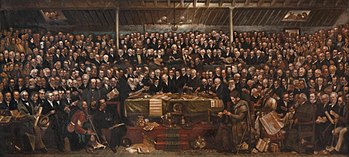
From this point there were moves towards reunion, and most of the Free Church rejoined the Church of Scotland in 1929. The schisms left small denominations including the Free Presbyterians and a remnant that had not merged in 1900 as the Free Church.[26] Catholic Emancipation in 1829 and the influx of large numbers of Irish immigrants led to an expansion of Catholicism, with the restoration of the Church hierarchy in 1878. Episcopalianism also revived in the 19th century; the Episcopal Church in Scotland was organised as an autonomous body in communion with the Church of England in 1804.[26] Other denominations included Baptists, Congregationalists, and Methodists.[26] In the twentieth century, existing Christian denominations were joined by the Brethren and Pentecostal churches. Although some denominations thrived, after World War II there was a steady overall decline in church attendance and resulting church closures in most denominations.[27]
Christianity
Protestantism
Church of Scotland (Presbyterian)

The British Parliament passed the Church of Scotland Act 1921, recognising the full independence of the church in matters spiritual, and as a result of this and passage of the Church of Scotland (Property and Endowments) Act, 1925, which settled the issue of patronage in the church, the Church of Scotland was able to unite with the United Free Church of Scotland in 1929. The United Free Church of Scotland was itself the product of the union of the former United Presbyterian Church of Scotland and the majority of the Free Church of Scotland in 1900.[26] The 1921 Act recognised the kirk as the national church and the monarch became an ordinary member of the Church of Scotland, represented at the General Assembly by their Lord High Commissioner.[29][30]
In the second half of the 20th century and afterwards the Church was particularly affected by the general decline in church attendance. Between 1966 and 2006 numbers of communicants in the Church of Scotland dropped from over 1,230,000 to 504,000.[31] Formal membership reduced from 446,000 in 2010 to 398,389 or 7.5% of the total population by year end 2013,[32] dropping to 325,695 by year end 2018 and representing about 6% of the Scottish population.[33] By 2020, membership had fallen further to 297,345 or 5% of the total population.[34] As at December 2021 there were 283,600 members of the Church of Scotland, a fall of 4.6% from 2020. In the ten years period (2011-2021) the number of members has fallen by 34%.[35] As at December 2022, there were 270,300 members of the Church of Scotland, a fall of 4.7% from 2021. In the last ten years, since 2012, the number of members has fallen by 35%.[36]
In 2016, the actual weekly attendance at a Kirk service was estimated to be 136,910.[37]: 16 In the twenty-first century the Church has faced financial issues, with a £5.7 million deficit in 2010. In response the church adopted a "prune to grow" policy, cutting 100 posts and introducing job-shares and unpaid ordained staff.[38] In the 2022 national census, 20.4% of Scots identified their religion as "Church of Scotland", which aligns with a 2019 Scottish Household Survey with showed 20% of Scots self-reported themselves as adherents.[39][40] By 2023, the Church estimated that around 60,000 people worshipped in church on a Sunday, a drop from 88,000 before the Covid pandemic.[41]
Other Presbyterian denominations
After the reunification of the Church of Scotland and the United Free Church, some independent Scottish Presbyterian denominations still remained. These included the Free Church of Scotland (formed of those congregations which refused to unite with the United Presbyterian Church in 1900), the United Free Church of Scotland (formed of congregations which refused to unite with the Church of Scotland in 1929), the Reformed Presbyterian Church of Scotland, the Free Presbyterian Church of Scotland (which broke from the Free Church of Scotland in 1893), the Associated Presbyterian Churches (which emerged as a result of a split in the Free Presbyterian Church of Scotland in the 1980s), and the Free Church of Scotland (Continuing) (which emerged from a split in the Free Church of Scotland in 2000).[42] In recent years, four congregations of the International Presbyterian Church have also arisen in Scotland, all founded as a result of evangelicals leaving the Church of Scotland over recent issues.[43] In addition, there are two congregations belonging to the Free Presbyterian Church of Ulster located in Scotland.[44] Similarly, five former Church of Scotland congregations have partnered together within the 'Didasko Presbytery' (Cornerstone Community Church, Stirling; Edinburgh North Church; Gilcomston Church, Aberdeen; Grace Church, Dundee; and The Tron Church, Glasgow).[45][46][47] [48] Thus, there are 10 Presbyterian denominations represented within Scotland.
At the 2011 census, 3,553 people responded as Other Christian – Presbyterian (i.e. not Church of Scotland), 1,197 as Other Christian – Free Presbyterian, 313 as Other Christian – Evangelical Presbyterian Church, and as few as 12 people as Other Christian – Scottish Presbyterianism. Those identifying with a particular Presbyterian denomination other than the Church of Scotland were:[8]
| Denomination | 1994 Sunday church attendance (Scottish Church Census) |
2002 Sunday church attendance (Scottish Church Census) |
2011 People identifying (National census)[8] |
2016 Sunday church attendance (Scottish Church Census)[37]: 18 |
|---|---|---|---|---|
| Free Church of Scotland | 15,510 | 12,810 | 10,896 | 10,210 |
| United Free Church of Scotland | 5,840 | 5,370 | 1,514 | 3,220 |
| Free Church of Scotland (Continuing) | Not yet split from FCofS | 1,520 | 830 | |
| Free Presbyterian Church of Scotland | 132 | |||
| Reformed Presbyterian Church | 57 | |||
| Free Presbyterian Church of Ulster | 14 | |||
| Presbyterian Church in Ireland | 11 |
Free Church of Scotland
The second largest Presbyterian denomination in Scotland is the Free Church of Scotland with 10,896 people identifying as being of that church at the 2011 census.[8] According to the Free Church, its average weekly attendance at a worship service is around 13,000.[49] According to the 2016 Church Census, Free Church attendance was around 10,000 per week and amounted to 7% of all Presbyterian church attendance in Scotland.[37]: 18 As of 2016 there were 102 Free Church congregations, organised into six presbyteries.[50] A significant proportion of Free Church activity is to be found in the Highlands and Islands.[51]
Scottish Episcopal Church
The Scottish Episcopal Church is the member church of the Anglican Communion in Scotland. It is made up of seven dioceses, each with its own bishop.[52] It dates from the Glorious Revolution in 1689 when the national church was defined as presbyterian instead of episcopal in government. The bishops and those that followed them became the Scottish Episcopal Church.[53]
Scotland's third largest church,[54] the Scottish Episcopal Church has 303 local congregations.[55] In terms of official membership, Episcopalians nowadays constitute well under 1 per cent of the population of Scotland, making them considerably smaller than the Church of Scotland that represents 6% of the Scottish population. The all-age membership of the church in 2018 was 28,647, of whom 19,983 were communicant members. Weekly attendance was 12,430.[56] One year earlier, in 2017, church membership had been 30,909, of whom 22,073 were communicant members.[57] For 2013, the Scottish Episcopal Church reported its numbers as 34,119 members (all ages).[58]
Other Protestant denominations
Other Protestant denominations which entered Scotland, usually from England, before the 20th century included the Quakers, Baptists, Methodists and Brethren. By 1907 the Open Brethren had 196 meetings and by 1960 it was 350, with perhaps 25,000 people. The smaller Exclusive Brethren had perhaps another 3,000. Both were geographically and socially diverse, but particularly recruited in fishing communities in the Islands and East.[42] In the 2011 census 5,583 identified themselves as Brethren, 10,979 as Methodist, 1,339 as Quaker, 26,224 as Baptist, and 13,229 as Evangelical.[8]
Pentecostal churches were present from 1908 and by the 1920s there were three streams: Elim, Assemblies of God and the Apostolic Church. A Holiness movement, inspired by Methodism, emerged in 1909 and by 1915 was part of the American Church of the Nazarene. The 2011 census lists 12,357 Pentecostals and 785 Church of the Nazarene.[8][59]
Catholicism

During much of the 20th century and beyond, significant numbers of Catholics emigrated to Scotland from Italy, Lithuania,[60] and Poland.[61] However, the church has been affected by the general decline in churchgoing. Between 1994 and 2002 Catholic attendance in Scotland declined 19%, to just over 200,000.[62] By 2008, the Bishops' Conference of Scotland estimated that 184,283 attended mass regularly in that year: 3.6% of Scotland's population.[63] According to the 2011 census, Catholics comprise 15.9% of the overall population.[64] In 2011, Catholics outnumbered adherents of the Church of Scotland in just four of the council areas, including North Lanarkshire, Inverclyde, West Dunbartonshire, and the most populous council, Glasgow City.[65] According to the 2019 Scottish Household Survey, 13% of the adult Scottish population identified with Catholicism.[66]
In February 2013, Cardinal Keith O'Brien resigned as Archbishop of St Andrews and Edinburgh after allegations of sexual misconduct against him.[67] Subsequently, there were several other cases of alleged sexual misconduct involving other priests.[68] O'Brien was replaced as Archbishop of St Andrews and Edinburgh by Leo Cushley.
Orthodoxy
The various branches of Orthodox Christianity (including Russian, Greek, and Coptic) had around 8,900 respondents at the 2011 census.[8]
Non-Trinitarian denominations
Non-Trinitarian denominations such as the Jehovah's Witnesses with 8,543 respondents in the 2011 census and The Church of Jesus Christ of Latter-day Saints with 4,651[8] are also present in Scotland. However, the LDS Church claims a much higher number of followers with their own 2009 numbers listing 26,536 followers (in 27 wards and 14 branches).[69]
Islam
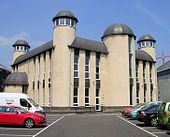
Islam is the second most followed religion after Christianity in Scotland. The first Muslim student in Scotland was Wazir Beg from Bombay (now Mumbai). He is recorded as being a medical student who studied at the University of Edinburgh between 1858 and 1859.[70] The production of goods and Glasgow's busy port meant that many lascars were employed there. Dundee was at the peak of importing jute; hence, sailors from Bengal were a feature at the port. The 1903 records from the Glasgow Sailors' Home show that nearly a third (5,500) of all boarders were Muslim lascars. Most immigration of Muslims to Scotland is relatively recent. The bulk of Muslims in Scotland come from families who immigrated during the late 20th century, with small numbers of converts.[71] In 2022 Muslims represented 2.2 per cent of the Scottish population (119,872, up from 76,737 in 2011). Two important mosques in Scotland are Glasgow Central Mosque and Edinburgh Central Mosque, which took more than six years to complete at a cost of £3.5m[72] and can accommodate over one thousand worshippers in its main hall.[73]
Judaism

Towards the end of the nineteenth century there was an influx of Jews, most from eastern Europe, escaping poverty and persecution. Many were skilled in the tailoring, furniture, and fur trades and congregated in the working class districts of Lowland urban centres, like the Gorbals in Glasgow. The largest community in Glasgow had perhaps reached 5,000 by the end of the century.[42] A synagogue was built at Garnethill in 1879. Over 8,000 Jews were resident in Scotland in 1903.[74] Refugees from Nazism and the Second World War further augmented the Scottish Jewish community, which has been estimated to have reached 80,000 in the middle of the century.[75]
According to the 2001 census, approximately 6,400 Jews lived in Scotland, however by the 2011 census this had fallen to 5,887.[7] Scotland's Jewish population continues to be predominantly urban, with 80 per cent resident in the areas surrounding Glasgow,[76] primarily East Renfrewshire, that area in particular containing 41% of Scotland's Jewish population, despite only containing 1.7% of the overall population. As with Christianity, the practising Jewish population continues to fall, as many younger Jews either become secular or intermarry with other faiths.[citation needed] Scottish Jews have also emigrated in large numbers to the US, England, and the Commonwealth for economic reasons, as with other Scots.[citation needed]
The formally organised Jewish communities in Scotland now include Glasgow Jewish Representative Council, Edinburgh Hebrew congregation and Sukkat Shalom Liberal Community, Aberdeen Synagogue and Jewish Community Centre, and Tayside and Fife Jewish Community. These are all represented by the Scottish Council of Jewish Communities, alongside groups like the Jewish Network of Argyll and the Highlands, Jewish students studying in Scottish universities and colleges, and Jewish people of Israeli origin living in Scotland.
Sikhism
According to the 2022 census, Sikhism represented 0.2% of the Scotland's population (10,988). Maharajah Duleep Singh moved to Scotland in 1854, taking up residence at the Grandtully estate in Perthshire.[77] According to the Scottish Sikh Association, the first Sikhs settled in Glasgow in the early 1920s with the first Gurdwara established on South Portland Street.[78] However, the bulk of Sikhs in Scotland come from families who immigrated during the late 20th century.
Hinduism
According to the 2022 census, 29,929 people identified as Hindu, representing 0.6% of the population of Scotland. The bulk of Scottish Hindus settled there in the second half of the 20th century. At the 2001 Census, 5,600 people identified as Hindu, which then equated to 0.1% of the Scottish population.[6] Most Scottish Hindus are of Indian origin, or at least from neighbouring countries such as Sri Lanka, Pakistan, Nepal, and Bangladesh. Many of these came after Idi Amin's expulsion from Uganda in the 1970s, and some also came from South Africa. There are also a few of Indonesian and Afghan origin. In 2006 a temple opened in the West End of Glasgow.[79] However, it was severely damaged by a fire in May 2010.[80] The ISKCON aka "Hare Krishna" also operates out of Lesmahagow in South Lanarkshire. There are also temples in Edinburgh and Dundee with plans announced in 2008 for a temple in Aberdeen.[81]
Buddhism
According to the 2022 census, 15,501 people in Scotland—0.3 per cent—are Buddhist.[82]
Modern Paganism
Modern Pagan religions such as Wicca, Neo-druidism, and Celtic Reconstructionist Paganism have their origins in academic interest and romantic revivalism, which emerged in new religious movements in the twentieth century.[83] Gerald Gardner, a retired British civil servant, founded modern Wicca. He cultivated his Scottish connections and initiated his first Scottish followers in the 1950s.[84] The Findhorn community, founded in 1962 by Peter and Eileen Caddy, became a centre of a variety of new age beliefs that mixed beliefs including occultism, animism, and eastern religious beliefs.[85] The ancient architectural landscape of pre-Christian Britain, such as stone circles and dolmens, gives pagan beliefs an attraction, identity, and nationalist legitimacy.[86] The rise of pan-Celticism may also have increased the attractiveness of Celtic neopaganism.[87] In the 2011 census 5,282 identified as Pagan or a related belief.[8] The Scottish Pagan Federation has represented Modern Pagans in Scotland since 2006.[88]
Bahá'í Faith
Scotland's Baháʼí history began around 1905 when European visitors, Scots among them, met `Abdu'l-Bahá, then head of the religion, in Ottoman Palestine.[89] One of the first and most prominent Scots who became a Baháʼí was John Esslemont (1874–1925). Starting in the 1940s a process of promulgating the religion called pioneering by Baháʼís began for the purpose of teaching the religion.[90] This led to new converts and establishment of local Spiritual Assemblies, and eventually a Baháʼí Council for all Scotland was elected under the National Assembly of the Baháʼís of the United Kingdom. According to the 2011 Census in Scotland, 459 people living there declared themselves to be Bahá'ís,[8] compared to a 2004 figure of approximately 5,000 Baháʼís in the United Kingdom.[91]
Irreligion
| Year | Pop. | ±% |
|---|---|---|
| 2001 | 1,394,460 | — |
| 2011 | 1,941,116 | +39.2% |
| 2022[5] | 2,780,900 | +43.3% |
| Religious Affiliation was not recorded prior to 2001. | ||
Ethnicity
The table shows the irreligious populations among ethnic groups and nationalities in Scotland.

